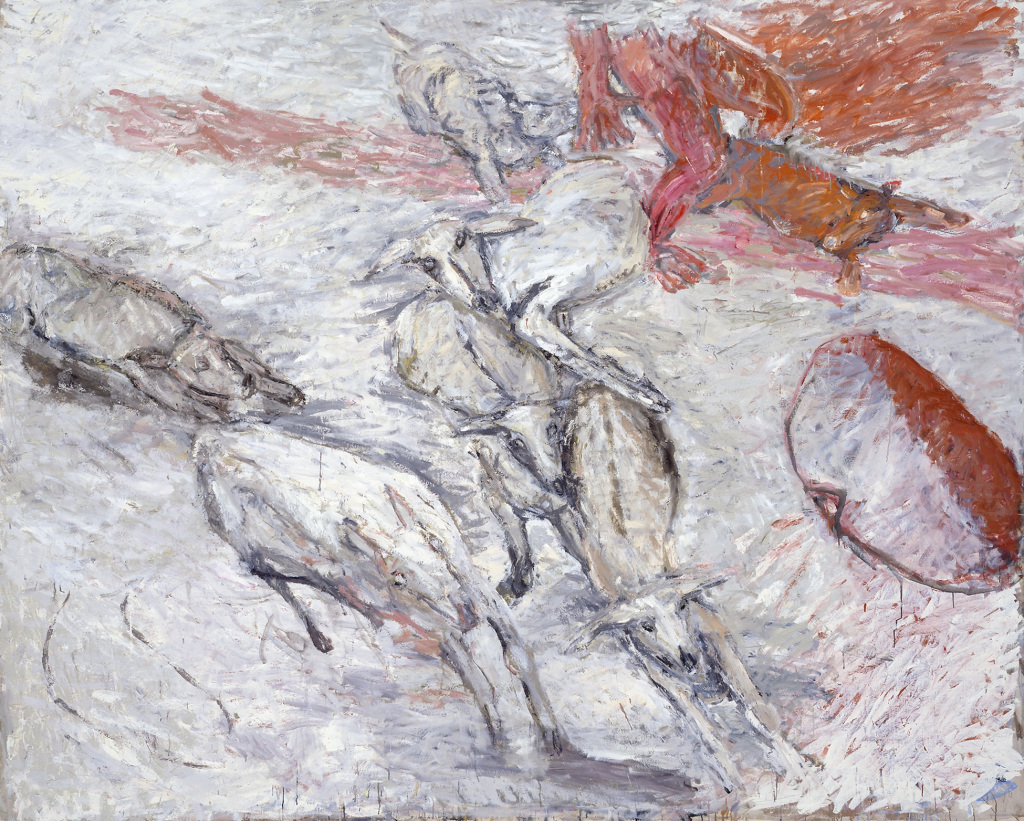[ad_1]
In an interview a few years ago, the artist Susan Rothenberg said she had just read that a group of ravens is called an unkindness. She thought it an unfair characterization because ravens, to her mind, were “great. They do somersaults in the air. They play. They chase hawks away. They do so many things.” She and her husband, the artist Bruce Nauman, regularly saw those famously fickle creatures at their ranch in Galisteo, New Mexico, and they’d earned enough of the birds’ trust to be able to walk up to them, though not to touch them. “It’s like having an unpettable pet around,” she said.
Rothenberg, who died earlier this week at 75, spent her life making raven-like paintings: rugged and raw, they beguile but never let you cozy up. She channeled animals (a category that includes humans) with a gimlet eye and without judgment, transmuting them into psychic and symbolic forces.
The horses came first. It was the mid-1970s, and she was an abstract artist in the downtown Manhattan art world, but she found herself doodling them on the back of scraps of paper. That year, she made the first of what would be many paintings of horses. She showed three at a scrappy SoHo alternative space. To her surprise, they would come to define her practice, and they would set her on a quicksilver course to become one of the shrewdest and most fearless painters of our time. (A lesson artists can take from her: Trust your weird ideas. Trust yourself.)

©2020 Susan Rothenberg/Artists Rights Society (ARS), New York/Courtesy Sperone Westwater, New York/Modern Art Museum Fort Worth, Texas
Rothenberg’s horses are often mid-gallop, frozen for a solitary moment at the center of a canvas. Because their bodies are merely outlined, frequently sharing the color of their earthen backgrounds (sienna, ochre, rose), they take on potent totemic weight. They portend primal, frightening events and moods: confinement, escape, the constant war between inner instinct and outside pressures. One clay-colored equine, with a fearsome black shadow, called Cabin Fever (1976), is “about being ready to go out and then going nowhere,” Rothenberg once said.
The white horse in For the Light (1978–79)—a spectral steed charging straight ahead—looks like it would trample you without a moment’s hesitation. In an especially spare untitled 1978 piece, which is just black lines on white, hands cradle a human head as it spews a thick, ashen-colored stream.
This is violent art, yes, but only as violent as anything that regularly happens in nature. The brutality that Rothenberg depicted was that born of survival mechanisms, rather than malevolence. In Dogs Killing Rabbit (1991–92)—a nearly 12-foot-long masterpiece owned by the Museum of Modern Art in New York—the former dismantle the latter in a flurry of reds, oranges, and browns. Rothenberg said that the scene came from life. She and Nauman were riding on horseback, and they tried to stop the carnage by shouting at the dogs. You can just make out two faces hovering at the painting’s upper-right edge, seeming faintly ridiculous as they try to bring order to chaos.

©2020 Susan Rothenberg/Artists Rights Society (ARS), New York/Courtesy Sperone Westwater, New York/Saint Louis Art Museum
Perspective, in Rothenberg’s paintings, is a topsy-turvy business. As in late Philip Guston, her paintings can offer multiple angles in one frame, or suggest an absence of gravity. (“I think certain experiences, most experiences probably, can’t be presented from one viewpoint,” she once said.)
As easily as she conveyed nature’s cruelty, Rothenberg could conjure boozy nights, freewheeling joy, and conviviality, as she did in the hands that manipulate dominoes in With Martini (2002), and the jumbled figures in Blue Funk (2001–02). Her improbable 1985 portrait of Piet Mondrian dancing in woozy, golden light is pure romance.
She never let up. This was an artist who once admitted that “I can’t understand those people who tell you they stopped working because they weren’t good enough. I feel, ‘How can you judge that you’re not good enough when you haven’t done the next one?’”
The next one. And then the next one after that. Rothenberg returned to subjects like dogs and ravens repeatedly. Sometimes they looked menacing, other times tender, provoking one to wonder whether such words anthropomorphize what is essentially inscrutable. One of Rothenberg’s goals, she said recently, was “being true to what I choose to paint.” Decades earlier, she made a remark that sounds like a corollary: “My art is about not taking anything for granted in this world.”
[ad_2]
Source link

